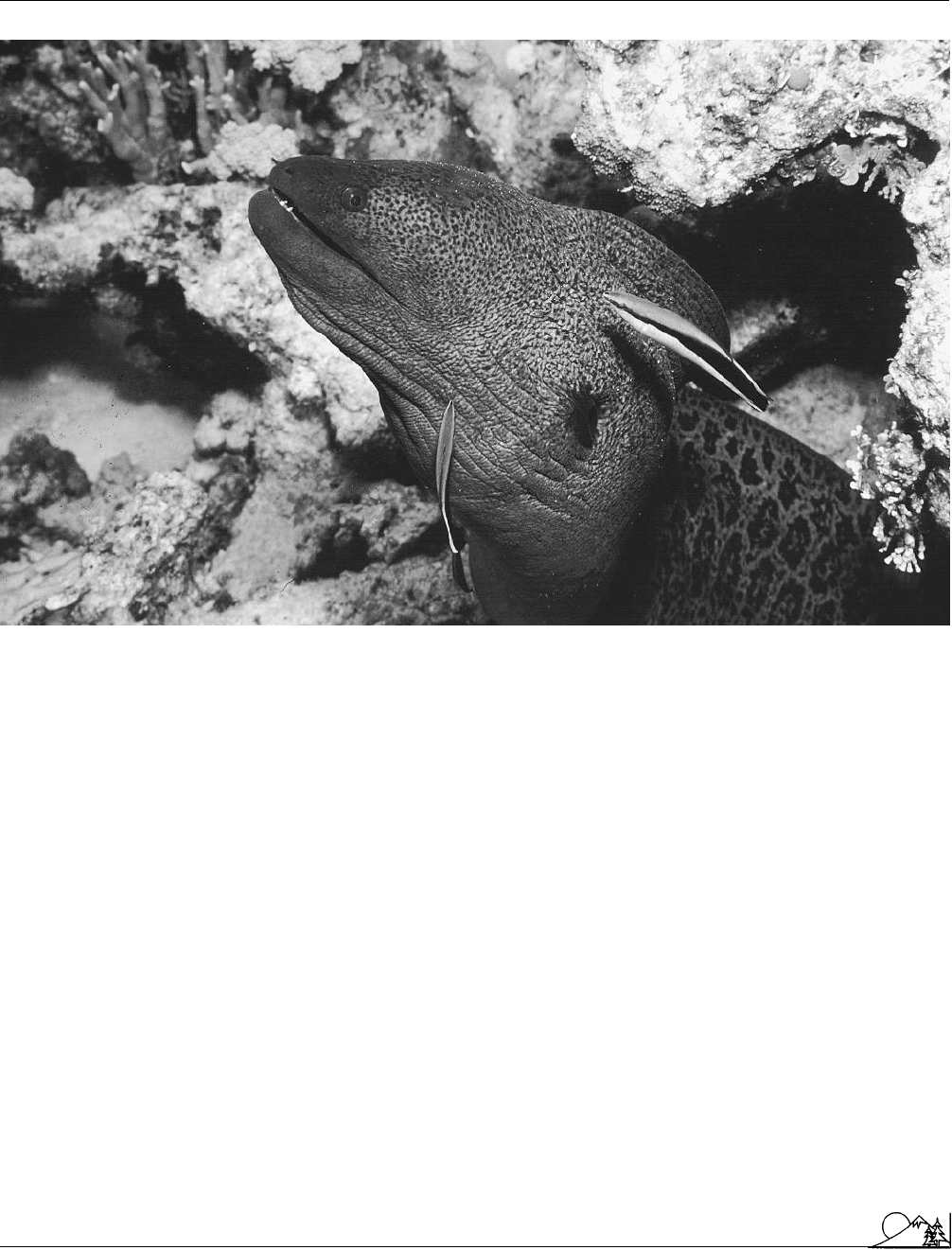Environmental Encyclopedia
Подождите немного. Документ загружается.


Environmental Encyclopedia 3
Sustainable biosphere
soil instead of increasing
pollution
in the
environment
.
Crop rotation reduces crop loss to insects and also increases
soil fertility. Monitoring
pest
populations helps determine
the best times as well as the best methods for eliminating
them, and using pesticides only when needed lowers pollu-
tion of soil and water and prevents insects from developing
resistances.
China provides one model of good land management.
Through techniques of
sustainable agriculture
which em-
phasize
organic farming
, China has met (though not ex-
ceeded) the nutritional needs of most of its people. On
Chinese farms,
methane
digesters recycle animal wastes,
by-products, and general refuse; the gas produced from the
digesters is in turn used as an energy source. Biological
controls are also used to reduce the number of harmful
insects and weeds. Crops are selected for their ability to
grow in particular locations, and
strip-farming
and
terrac-
ing
help conserve the soil. Crops that put certain nutrients
in the soil are planted in alternate rows with crops that
deplete those nutrients. Forests, important for
watershed
and as a fuel source, are maintained. Fish farming, or
aqua-
culture
, is widely practiced, and the fish raised on these
farms produce about 10 times more animal protein than
livestock raised on the same amount of land. In China,
agriculture relies upon human labor rather than more expen-
sive and environmentally harmful machinery, which has the
added advantage of keeping millions of people gainfully
employed.
Another important aspect of land management is
bio-
diversity
. Each organism is specially suited for its
niche
,
yet all are interconnected, each depending on others for
nutrients, energy, the purification of wastes, and other needs.
Plants provide food and oxygen for animals, sustain the
hydrocycle, and protect the soil. Animals help pollinate
plants and give off the
carbon dioxide
that plants need
to generate energy.
Microorganisms
recycle wastes, which
returns nutrients to the system. The activity of many of these
organisms is directly useful to humans. Additionally, having
a broad range of organisms means a broad source of genetic
material from which to create new, as well as better, crops and
livestock. However, a reduction in the number of
species
reduces biological diversity.
Hunting
can destroy species, as
can eliminating habitats by cutting down forests, draining
wetlands
, building cities and polluting excessively.
The water portion of the biosphere has two intercon-
nected parts. Freshwater lakes and rivers account for about
3% of the earth’s water, while the oceans contain the other
97%. Oceans are important to the biosphere in a number
of ways. They absorb some of the gases in the air, regulating
its composition, and they influence
climate
all over the
earth, preventing drastic weather changes. Additionally, the
ocean contains a myriad of plant and animal species, which
1367
provide food for humans and other organisms and aid in
maintaining their environment.
However, according to many scientists, exploitation
of the oceans must be curtailed to ensure that they remain
viable. Their argument is that species are too often harvested
until they are destroyed, creating an imbalance in the
ecosys-
tem
, and that fishing quotas that do not allow populations
to be depleted faster than they can be replaced should be
set and enforced. Rather than harvesting immature fish,
the
commercial fishing
industry should release them, thus
keeping the species population in equilibrium. Pressure must
also be taken off individual species, and interactions in the
ocean ecosystem should be examined. A strategy designed
to consider these factors would benefit the whole ocean
community as well as humans. Pollution of the ocean should
also be reduced. Pollution can take the form of
garbage
,
sewage, toxic wastes, and oil. In excess, these harm the
organisms of the ocean, which in turn harms humans. Dis-
posal of these substances should be controlled through,
though not limited to,
sewage treatment
,
discharge
re-
strictions and improved dispersal techniques.
Although freshwater is a renewable resource, care
needs to be taken to keep it clean. Wise water management,
which includes monitoring water supplies and
water qual-
ity
, can ensure that everyone’s needs are met. Agriculture
and commercial fishing require water, and manufacturing
industries use water in many of their processes. Households
consume water in cooking, cleaning, and drinking, among
other activities. Without water, certain recreations such as
water skiing and swimming would be impossible to enjoy.
Wildlife
and fish also need water to survive.
Pollutants reduce and damage the freshwater supply.
Pollutants include
chemicals
, sewage, toxic waste, hot water,
and many other organic and inorganic materials. Waste
leaching
from landfills contaminates
groundwater
, and
surface water is corrupted by wastes dumped into the water
by polluted groundwater flowing into the stream or lake, or
by polluted rain. Like oceans, freshwater can break down
small amounts of pollutants, but large amounts place great
pressure on the system. Disposal of potential pollutants re-
quires monitoring and treatment. A useful strategy is to
balance the demands of humans with the needs of the ecosys-
tem, emphasizing conservation and pollution reduction.
As with land and water, the atmosphere has been
adversely affected by pollution. Pollution in the air causes
such phenomena as
smog
,
acid rain
,
atmospheric inver-
sion
, and
ozone layer depletion
. Smog lowers the amount
of oxygen in the air, which can cause health problems.
Acid
rain destroys plants, animals, and freshwater supplies. Atmo-
spheric inversion exists when
air pollution
is unable to
escape because a layer of warm air covers a layer of cooler
air, trapping it close to the ground. Certain compounds, such

Environmental Encyclopedia 3
Sustainable development
as chlorofluoromethanes, thin the
ozone
layer by combining
with ozone to split it apart. A thinner ozone layer provides
less protection from the sun’s
ultraviolet radiation
, which
promotes skin
cancer
in humans and reduces the productiv-
ity of some crops. Reducing or eliminating harmful emissions
can also control air pollution.
Sustainable development
is one approach to keep-
ing the biosphere healthy. This method attempts to increase
local food production without increasing the amount of land
taken. It involves
nature
conservation and
environmental
monitoring
, and it advocates encouraging and training local
communities to participate in maintaining the environment.
The goal is to balance human needs with environmental
needs, and proponents of this view maintain that economic
growth depends on renewable resources, which in turn de-
pends on permanent damage to the environment being kept
at a minimum.
The
Ecological Society of America
published the
Sustainable Biosphere Initiative (SBI) in the early 1990s.
This document was an attempt to define ecological priorities
for the twenty-first century, and it is based on the realization
that research in applied
ecology
is necessary for better man-
agement of the earth’s resources and of the systems that
support life. The SBI calls for basic ecological research and
emphasizes the importance of education and policy and man-
agement decisions informed by such research.
TheSBI sets out criteria fordetermining which research
projects should be pursued, and it proposes three top research
priorities: global change, biodiversity, and sustainable ecolog-
ical systems. Global change research focuses on the causes and
effects of various changes in all aspects of the biosphere (air,
water, land). Biodiversity research focuses on both naturally
occurring and human-caused changes in species. It also stud-
ies the consequences of those changes. Research on sustain-
able ecological systems exams the pressures placed on the bio-
sphere, methods of correcting the damage and management
of the environment to maintain life.
Creating a sustainable biosphere requires a cohesive
policy for reducing consumption and seeking nonmaterial
means of satisfaction. Many believe that such a cohesive policy
would provide a much-needed focus for the many diverse en-
vironmental interests currently vying for public support.
[Nikola Vrtis]
R
ESOURCES
B
OOKS
Myers, N., ed. GAIA: An Atlas of Planet Management. Garden City, NY:
Anchor Press/Doubleday, 1984.
1368
P
ERIODICALS
“Biosphere Reserves.” Futurist (May-June 1992): 31–32.
Lubchenco, J., et al. “The Sustainable Biosphere Initiative: An Ecological
Research Agenda.” Ecology 72 (1991): 371–412.
Risser, P. G., J. Lubchenco, and S. A. Levin. “Biological Research Priori-
ties–A Sustainable Biosphere.” Bioscience (October 1991): 625–627.
Sustainable development
Sustainable development is a term first introduced to the
international community by
Our Common Future
, the 1987
report of the World Commission on
Environment
and De-
velopment, which was chartered by the United Nations to
examine the planet’s critical social and environmental prob-
lems and to formulate realistic proposals to solve them in
ways that ensure sustained human progress without deplet-
ing the resources of
future generations
. This Commis-
sion—which was originally chaired by
Gro Harlem Brundt-
land
, Prime Minister of Norway, and was consequently
often called the Brundtland Commission—defined sustain-
able development as “meeting the needs of the present with-
out compromising the ability of future generations to meet
their own needs.” The goal of sustainable development, ac-
cording to the Commission, is to create a new era of eco-
nomic growth as a way of eliminating poverty and extending
to all people the opportunity to fulfill their aspirations for
a better life.
Economic growth, in this view, is the only way to
bring about a long-range transformation to more advanced
and productive societies and to improve the lot of all people.
As former President John F. Kennedy said: “A rising tide
lifts all boats.” But economic growth is not sufficient in itself
to meet all essential needs. The Commission, which was
actually named the Commission on Sustainable Develop-
ment, or CSD, pointed out that we must make sure that the
poor and powerless will get their fair share of the resources
required to sustain that growth. The CSD stated that “an
equitable distribution of benefits requires political systems
that secure effective citizen participation in decision making
and by greater democracy in international decision making.”
The concept of “sustainable” growth of any sort is
regarded as an oxymoron by some people because the avail-
ability of
nonrenewable resources
and the capacity of the
biosphere
to absorb the effects of human activities are
clearly limited and must impose limits to growth at some
point. Nevertheless, supporters of sustainable development
maintain that both technology and social organization can
be managed and improved to meet essential needs within
those limits.
To clarify this concept, a discussion of what is develop-
ment and what is meant by “sustainable” is necessary. Devel-
opment is a process by which something grows, matures,

Environmental Encyclopedia 3
Sustainable development
improves, or becomes enhanced or more fruitful. Organisms
develop as they progress from a juvenile form to an adult.
The plot in a novel develops as it becomes more complex,
clearer, or more interesting. Human systems develop as they
become more technologically, economically, or socially ad-
vanced and productive. In human history, social develop-
ment usually means an improved standard of living or a
more gratifying way of life.
Something is sustainable if it is permanent, enduring,
or can be maintained for the long-term. Sustainable develop-
ment, then, means improvements in human well-being that
can be extended or prolonged over many generations rather
than just a few years. The hope of sustainable development
is that if its benefits are truly enduring, they may be extended
to all humans rather than just the members of a privileged
group.
Some development projects have been viewed by some
as environmental, economic, and social disasters. Large-scale
hydropower projects--for instance in the James Bay region
of Quebec or the Brazilian Amazon--were supposed to be
beneficial but displaced indigenous people, destroyed
wild-
life
, and poisoned local ecosystems with acids from decaying
vegetation and
heavy metals
from flooded soils released
through
leaching
. Similarly, introduction of “miracle” crop
varieties in Asia and huge grazing projects in Africa financed
by international lending agencies crowded out wildlife, di-
minished the diversity of traditional crops, and destroyed
markets for small-scale farmers.
Other development projects, however, worked more
closely with both
nature
and local social systems. Projects
such as the Tagua Palm Nut project sponsored by
Conserva-
tion International
in South America encouraged native
people to gather natural products from the forest on a sus-
tainable basis and to turn them into valuable products (in
this case “vegetable ivory” buttons) that could be sold for
good prices on the world market. Another exemplary local
development project was the “microloan” financing pion-
eered by the grameen or village banks of Bangladesh. These
loans, generally less than $100, allowed poor people who
usually would not have access to capital to buy farm tools,
a spinning wheel, a three-wheeled pedicab, or some other
means of supporting themselves. The banks were not con-
cerned merely with finances, however; they also offer busi-
ness management techniques, social organization, and edu-
cation to ensure successful projects and loan repayment.
Still, critics of sustainable development argue that the
term is self-contradictory because almost every form of devel-
opment requires resource consumption. The limits and
boundaries imposed by natural systems, they argue, must at
some point make further growth unsustainable. Using ever-
increasing amounts of goods and services to make human
life more comfortable, pleasant, or agreeable must inevitably
1369
interfere with the survival of other
species
and eventually
of humans themselves in a world of fixed resources.
While it is probably true that traditional patterns of
growth that require ever-increasing consumption of re-
sources are unsustainable, development could be possible if
it means: (a) finding more efficient and less environmentally
stressful ways to provide goods and services; and (b) living
with reduced levels of goods and services for those of us
who are relatively rich so that more can be made available
to the impoverished majority.
Some economists argue that the physical limits to
growth are somewhat vague, not because the laws of physics
are inaccurate, but because substituting one resource for
another in producing goods and services allows a tremendous
flexibility in the face of declining abundance of some re-
sources. For example, the extremely rapid adoption of
petro-
leum
products as sources of energy and raw materials in the
early twentieth century is a good case study of how quickly
new discoveries and technical progress can change the re-
source picture.
From this perspective, the decline of known petroleum
reserves and the effects of gases from the
combustion
of
petroleum products on possible global warming—while seri-
ous problems—are also signals to humans to look for substi-
tutes for these products, to explore for unknown reserves,
and to develop more efficient and possibly altogether new
ways of performing the tasks for which oil is now used.
Teleconferencing, for instance, which allows people at widely
distant places to consult without traveling to a common
meeting site, is a good example of this principle. It is far
more energy-efficient to transmit video and audio informa-
tion than to move human bodies.
The issues of distributive justice or fairness between
“developed” and “developing” societies—concerned with
who should bear the burden of sustaining future development
and how resources will be shared in development—raise
many difficult questions. Similarly, the technical problems
of finding new, efficient, non-destructive ways of providing
goods and services require entirely new ways of doing things.
The range of theoretical understanding, personal and group
activity, and policy and politics encompassed by this project
is so vast that it might be considered the first time humans
have tried to grasp all their activities and the workings of
nature in its entirety as one integrated, global system.
The first planet-wide meeting to address these global
issues was the
United Nations Conference on the Human
Environment
which took place in 1972. It was followed by
the
United Nations Earth Summit
held in June, 1992, in
Rio de Janeiro, Brazil. The scope of sustainability issues
taken up at the Earth Summit is in itself remarkable. Agenda
21, a 900-page report drafted in preparation for the confer-
ence, included proposals for allocation of international aid

Environmental Encyclopedia 3
Sustainable forestry
to alleviate poverty and improve
environmental health
.
Other recommendations included providing
sanitation
and
clean water to everyone, reducing indoor
air pollution
,
meeting basic healthcare needs for all, reducing
soil erosion
and degradation, introducing sustainable farming tech-
niques, providing more resources for
family planning
and
education (especially for young women), removing economic
distortions and imbalances that damage the environment,
protecting
habitat
and
biodiversity
, and developing non-
carbon energy alternatives.
In June 1997, a follow-up Earth Summit was held
to adopt a comprehensive program to further implement
Agenda 21. Those attending developed a multi-year program
of work that addressed themes and economic sectors each
year. Examples include global attention to freshwater man-
agement, oceans and seas, agriculture and forests, the
atmo-
sphere
and energy. The CSD is made up of elected members
from Member States of the United Nations, and its 2001
chair was Professor Bedrich Moldan of the Czech Republic.
See also Amazon basin; Greenhouse effect
[Eugene R. Wahl and E. Shrdlu]
R
ESOURCES
B
OOKS
Leonard, H. J., et al. Environment and the Poor: Development Strategies for
a Common Agenda. New Brunswick: Transaction Books for the Overseas
Development Council, 1989.
MacNeill, J., et al. Beyond Interdependence: The Meshing of the World’s
Economy and the Earth’s Ecology. New York: Oxford University Press, 1991.
Ramphal, S. Our Country, The Planet. Covelo, CA: Island Press, 1992.
World Bank. World Development Report: Development and the Environment.
New York: Oxford University Press, 1992.
World Commission on Environment and Development. Our Common Fu-
ture. New York: Oxford University Press, 1987.
O
THER
“About Commission on Sustainable Development.” United Nations Sustain-
able Development [cited July 9, 2002]. <http:www.un.org/esa/sustdev/
csdgen.htm>.
O
RGANIZATIONS
United Nations Commission on Sustainable Development, United Nations
Plaza, Room DC2-2220, New York, NY, USA 10017, 212-963-3170,
Fax: 212-963-4260, Email: dsd@un.org, <www.un.org/esa/sustdev/>
Sustainable forestry
Sustainability may be defined in terms of sustaining bio-
physical properties of the forest, in terms of sustaining a
flow of goods and services from the forest, or a combination
of the two. A combined definition follows: sustainable
forests are able to provide goods and services to the present
without impairing their capacity to be equally or more
useful to
future generations
. The goods and services
1370
demanded of the forest include wood of specified quality;
habitat
for
wildlife
, fish, and invertebrates; recreational,
aesthetic, and spiritual opportunities; sufficient water of
appropriate quality; protection (e.g., against floods and
erosion
); preservation of natural ecosystems and their
processes (i.e. allowing large forested landscapes to be
affected only by natural dynamics); and the preservation
of
species
.
To provide in perpetuity for future demands, the pro-
ductivity, diversity, and function of the forest must be main-
tained and enhanced. A listing of key biophysical properties
follows, along with examples of current threats to their main-
tenance: 1)
Soil
productivity (reduced by erosion and
nutri-
ent
depletion from overharvesting). 2)
Biomass
(degraded
in quantity and quality by overharvesting and destructive
logging
practices). 3) Climatic
stability
(possibly threat-
ened by
emission
of
greenhouse gases
). 4) Atmospheric
quality (lowered by
ozone
and
sulfur dioxide
). 5) Ground
and surface waters (altered by
deforestation
or
drainage
).
6) Diversity of plants, animals, and ecosystems (reduced by
deforestation, fragmentation, and replacement of complex
natural forests with even-aged forests harvested at young
ages).
Forest sustainability also depends on the maintenance
and improvement of socioeconomic factors. These include
human talent and knowledge; infrastructure (e.g., roads);
and political, social, and economic institutions (e.g., mar-
keting systems, stable political systems, international coop-
eration, and peace). Also essential are technological devel-
opments that permit wiser use of the forest and substitute
ways to meet human needs. Perhaps the major threat to
forest sustainability arises from an ever-increasing popula-
tion, especially in developing countries, combined with
the ever-increasing material demands of the developed
nations.
Forests have been managed as a renewable and sustain-
able resource by stable indigenous tribes for many genera-
tions. In recent years, some governments have made efforts
in this direction as well. Managing any forest for sustainabil-
ity is a complex process. The spatial scale of sustainability
is often global or regional, crossing land ownerships and
political boundaries. The time horizons for sustainability by
far exceeds those used for “long-term” planning by business
or government.
Some people have even questioned the feasibility
of sustainable forestry. Optimists believe technological
innovation and changed value systems will enable us to
achieve sustainability. Others feel demand will outstrip
supply, leading to spiralling forest degradation, and have
called for conservative and careful management of existing
forests.
[Edward Sucoff]

Environmental Encyclopedia 3
Swimming advisories
R
ESOURCES
B
OOKS
Kimmins, H. Balancing Act. UBI Press, 1992.
World Resource Institute. World Resources 1992-1993. New York: Oxford
Press, 1992.
Swamp
see
Mangrove swamp; Wetlands
Swimming advisories
Swimming advisories are warnings to the public that contact
with beach water could cause an illness. Advisories may be
issued after water monitoring, testing that reveals potentially
harmful bacteria levels. Water monitoring assesses levels of
E. coli and fecal coliform contamination in recreational wa-
ters. Local authorities restrict use of water for recreational
activities when the bacteria level exceeds standards for safe
usage.
A beach may be closed when the level of water contam-
ination poses a definite health risk. Mildly polluted water
can cause conditions such as a headache, sore throat, or
vomiting. Highly polluted water can cause hepatitis,
chol-
era
, and typhoid fever.
Swimming advisories are usually issued by governmen-
tal agencies and apply to public beaches at the ocean and
waterways such as bays, lakes, and rivers. Advisories may be
issued for public pools, too. However, not all states had
programs to monitor
water quality
and issue public advi-
sories as of May of 2002.
According to the U.S.
Environmental Protection
Agency
(EPA), state and local governments issued nearly
4,000 beach closings and swimming advisories in 1995.
Those actions involved the ocean, bays, and the
Great
Lakes
. In 2000, there were at least 11,270 beach closings
and advisories in the United States, according to the
Natural
Resources Defense Council
. NRDC also reported 48 ex-
tended closings and advisories that lasted from six to 12
weeks. Also reported were 50 permanent closings and advi-
sories that lasted for more than 12 weeks.
NRDC is an environmental group that has surveyed
beaches since 1990. Each July, the group issues “Testing the
Waters,” a state-by-state assessment of beaches. The survey
covers ocean, bay, and Great Lakes beaches. The report was
based on information from local, county, state and federal
agencies including the EPA.
According to NRDC, 11 states and Guam monitored
water quality at all beaches at least once a week. Regular
monitoring of all beaches was performed in California, Con-
necticut, Delaware, Hawaii, Illinois, Indiana, New Hamp-
1371
shire, New Jersey, North Carolina, Ohio, and Pennsylvania.
Monitoring of some beaches was performed at least weekly
in Alabama, Florida, Georgia, Maine, Maryland, Massachu-
setts, Michigan, Minnesota, Mississippi, New York, Rhode
Island, South Carolina, Texas, Virginia, Wisconsin, Puerto
Rico, and the Virgin Islands.
In states where monitoring improved, there was more
awareness about unhealthy water quality. More monitoring
led to additional advisories and closures. The 2000 NRDC
report ranked California at the top of the state list in terms
of advisories and closures. Nearly one-third of California
advisories and closures occurred in San Diego and Los
Angeles counties.
An example of procedures for swimming advisories
can be found in a San Diego County report for 2001. For
the county, 2001 was the first full year that San Diego
followed regulations in the state Beach Safety Bill. In 2001,
water contamination caused 1,301 advisory and closure days,
according to a report from the San Diego County Depart-
ment of Health.
An advisory was triggered when bacterial levels ex-
ceeded state standards. Sources of bacteria could include
human or
animal waste
,
soil
, or decaying plant material.
During an advisory, signs on the beach warn, “Contact With
This Water May Cause An Illness.”
Beach closings can be caused by sewage spills. These
pose the greatest health risk to swimmers, and beach signs
warned, “Contaminated Water — Keep Out.”
San Diego County also listed 72-hour general advi-
sories. The three-day advisories occurred after rainfall mea-
suring 0.2 in (0.5 cm) or more. Rainfall washes pollutants
off areas like streets. Pollutants traveled to the ocean through
storm drains. Advisories were posted on the County Web
page and phone tape, and in the local newspaper.
San Diego was typical of beach cities in terms of
what caused
water pollution
and illnesses. Sources of water
pollution
include water
runoff
, malfunctioning
sewage
treatment
plants, and the waste and litter left by people.
People are at risk when they swim or come into contact
with polluted water. The risk of illness increases when a
person swallows water. Furthermore, direct exposure to
water sometimes causes skin and eye infections, according
to the EPA.
The EPA advised the public to visit beaches that are
regularly monitored. Groups including the EPA provide
beach monitoring information on their Web sites. The EPA
also cautioned people against swimming near sewage
dis-
charge
pipes and to avoid swimming in urban beaches after
a heavy rainfall.
Groups campaigning for national water monitoring
policy include
American Oceans Campaign
, an organiza-

Environmental Encyclopedia 3
Swordfish
tion founded by actor Ted Danson. In 2002, American
Oceans Campaign and NRDC were among the groups that
wanted the Bush administration to implement federal
water
quality standards
that President Bill Clinton approved
before leaving office in 2000.
The Beaches Environmental Assessment and Coastal
Health (BEACH) Act of 2000 authorized $30 million for
beach monitoring grants. States with coasts and bays and
those containing the Great Lakes are eligible for grants
allocated through the EPA. States can use the grants to set
up or improve programs to monitor water quality. Grant
money can also be used for programs to inform the public
about water pollution. In 2002, President George W. Bush
budgeted $2 million for BEACH grants.
[Liz Swain]
R
ESOURCES
O
RGANIZATIONS
American Oceans Campaign., 600 Pennsylvania Avenue SE, Suite 210,
Washington, D.C. USA 20003, (202) 544-3526, Fax: (202)544-5625,
Email: info@americanoceans.org, <http://www.americanoceans.org>
Environmental Protection Agency Office of Water (4101M), 1200
Pennsylvania Avenue, N.W., Washington, D.C. USA 20460, (202) 566-
0388, Fax: (202) 566-0409, Email: OW-GENERAL@epa.gov, <http://
www.epa.gov/waterscience/beaches/>
Natural Resources Defense Council., 40 West 20th Street, New York,
NY USA 10011, (212) 727-2700, Fax: (212) 727-1773, Email:
nrdcinfo@nrdc.org, <http://www.nrdc.org>
Swordfish
The swordfish, Xiphias gladius, is classified in a family by
itself, the Xiphiidae. This family is part of the Scombroidea,
a subfamily of marine fishes that includes tuna and mackerel.
Tuna and mackerel are two of the fastest-swimming
creatures in the ocean. Swordfish rival them, as well as mako
sharks
, with their ability to reach speeds approaching 60
mph (96.5 kph) in short bursts. Their streamlined form and
powerful build account for their speed, as well as the fact
that their torpedo-shaped body is scaleless and smooth, thus
decreasing surface drag. Swordfish have a tall, sickle-shaped
dorsal fin that cuts through the water like a knife, and their
long pectoral fins, set low on their sides, are held tightly
against their body while swimming. Swordfish lack pelvic
fins, and they have reduced second dorsal and anal fins which
are set far back on the body, adding to the streamlining. It
has been suggested that their characteristic “sword"—a
broad, flat, beak-like projection of the upper jaw—is the
ultimate in streamlining. The shape of their bill is one of
the characteristics that separates them from the true billfish,
which include sailfish and marlin.
1372
Swordfish live in temperate and tropical oceans and
are particularly abundant between 30 and 45 degrees north
latitude. They are only found in colder waters during the
summer months. Although fish in general are cold-blooded
vertebrates, swordfish and many of their scombroid relatives
are warm-blooded, at least during strenuous activity, when
their blood will be several degrees higher than the sur-
rounding waters. Another physiological
adaptation
is an
increased surface area of the gills, which provides for addi-
tional oxygen transfer and thus allows swordfish to swim
faster and longer than other
species
of comparable size.
Swordfish are valuable for both sport fishing and
com-
mercial fishing
. The size of swordfish taken commercially is
usually under 250 lb (114 kg), but some individuals have been
caught that weighover 1,000 lb (455 kg). The seasonal
migra-
tion
of this species has meant that winter catches are limited,
but long-lining in deep waters off the Atlantic coast of the
United States has proven somewhat successful in that season.
Swordfish have only become popular as food over the
past 50 years. Their overall commercial importance was re-
duced in the 1970s, however, when relatively high levels of
mercury
were discovered in their flesh. Because of this
discovery, restrictions were placed on their sale in the United
States, which had a negative effect on the fishery. Mercury
contamination was thought to be solely the result of dramatic
increase in industrial
pollution
, but recent studies have
shown that high levels of mercury were present in museum
specimens collected many years ago. Although still a critical
environmental and health concern, industrial sources of mer-
cury contamination have apparently only added to levels from
natural sources. Today, swordfish is considered somewhat of
a luxury food item, sold at fine dining establishments.
Like any delicacy, swordfish entrees catch a tasty price
for the establishments that serve them, but at what cost to the
environment
? In 1999 alone, global fisheries caught roughly
55,000 tons of swordfish. About 40% of the all swordfish
caught comes from the Pacific Ocean. California fisheries ac-
countfor about 10% of thePacific proportion netted each year.
As mentioned, until the middle of this century, most of the
swordfish caught were relatively large in size. By 1995, how-
ever, about 58% of the Atlantic swordfish caught were imma-
ture, weighing less than half the average adult mass. Juvenile
fish are now caught more frequently because fishing tech-
niques have become very efficient, leading to
overfishing
.
According to the
Natural Resources Defense Coun-
cil
, an active
conservation
organization, two-thirds of the
swordfish caught by United States fishermen are juvenile.
In 1963, the average weight of swordfish caught was 250 lb
(114 kg). The average weight of swordfish caught in 1999
was 90 lb (41 kg). Among conservation scientists, it is gener-
ally agreed that the minimum weight a female swordfish
must attain for reproductive success is roughly 150 lb (68

Environmental Encyclopedia 3
Symbiosis
kg). Standards set by the International Commission for the
Conservation of Atlantic Tunas (ICCAT), however, set a
minimum weight limit at 50 lb (23 kg), well below reproduc-
tive weight. The ICCAT, a regulatory council consisting of
36 nations that governs global swordfish and tuna fish
catches, has limited overfishing by setting quotas for its
member countries. Unfortunately, scientists believe that
swordfish populations are still in danger because most sword-
fish are not reaching reproductive age before being caught.
Government agencies have warned fisheries that
swordfish populations are in danger. The United States Ma-
rine Fisheries Service reports that the global swordfish num-
bers have decreased by 70% since the 1960s. Also, it is
believed that if the present rate of decline continues, sword-
fish will become commercially extinct (too few in number
to be profitable) within a decade. Despite this, excessive
catching of swordfish remains a problem. In an effort to
limit the rate and extent of swordfish decline, a boycott and
marine conservation campaign was launched. In 1998, the
swordfish became the official symbol of global overfishing
for the National Coalition for Marine Conservation, repre-
senting dozens of
endangered species
. That year, environ-
mental organizations such as the Natural Resource Conser-
vation Council and Seaweb created a partnership with
prominent chefs at famous fine dining establishments across
the nation. Participating restaurants, leading the boycott,
removed swordfish from their menus while the environmen-
tal awareness groups spread the word about swordfish de-
cline. Restaurants in Dallas, Philadelphia, Boston, New York
City, and Baltimore were among the cities that led the
boycott.
Resteraunts also took swordfish off the menu due to
high levels of mercury. The
Food and Drug Administration
has set the level of 1 part per million (ppm), but some
samples of swordfish have come up as triple that regulated
amount. Due to these large amounts, the FDA recommends
that women who are or may become pregnant and small
children avoid eating swordfish. Although it is too soon to
tell, this may have a large impact on the current status of
the fish.
In 1999, Carl Safina, director of the Living Oceans
Program of the
National Audubon Society
, published the
book Song for the Blue Ocean. In response to the dramatic
changes in fish populations that were being observed, his
book urged readers to adopt an interest in the oceans and
the growing threat to their ecological
stability
. Still regarded
by many to be an unchangeable expanse and infinite source
of goods, Safina alerts readers of the threat of human progress
to the ocean, the world’s largest
ecosystem
. Inspiring activ-
ism, and some controversy, Safina’s book exposes how hu-
man activity affects even the ocean’s inhabitants. Among
the list of species discussed as being in peril is the swordfish.
1373
With efforts such as the restaurant boycott, federal conserva-
tion regulation improvements, and social interventions such
as the book Song for the Blue Ocean, it is hoped that swordfish
populations will make a steady come back within the next
decade. Their fate, however, ultimately depends upon con-
sumers, who control demand.
[Eugene C. Beckham]
R
ESOURCES
B
OOKS
Burton, R., C. Devaney, and T. Long. The Living Sea: An Illustrated
Encyclopedia of Marine Life. New York: G. P. Putnam’s Sons, 1974.
Hoese, H., and R. Moore. Fishes of the Gulf of Mexico: Texas, Louisiana,
and Adjacent Waters. College Station: Texas A & M University Press, 1977.
McClane, A. Field Guide to Saltwater Fishes of North America. New York:
Holt, Rinehart, & Winston, 1978.
Nelson, J. Fishes of the World. New York: Wiley, 1976.
Wheeler, A. Fishes of the World: An Illustrated Dictionary. New York: Mac-
Millan, 1975.
Symbiosis
In the broad sense, symbiosis means simply “living to-
gether"—the union of two separately evolved organisms into
a single functional unit regardless of the positive or negative
influence on either
species
.
Symbiotic relationships fall into three categories.
Mu-
tualism
describes the condition in which both organisms
benefit from the relationship,
commensalism
exists when
one organism benefits and the other is unaffected, and para-
sitism describes a situation in which one organism benefits
while the other suffers. Symbionts may also be classified
according to their mode of life. Endosymbionts carry out
the relationship within the body of one species, the host.
Exosymbionts are attached to the outside of the host in a
variety of ways, or are unattached, seeking contact for specific
purposes or at particular times. Similarly, symbionts may
either be host-specific, co-evolved to one species in particu-
lar, or a generalist, able to make use of many potential
partners. In either case, the relationship usually involves co-
evolutionary levels of integration, where partners influence
each other’s fitness.
Symbiosis generally requires either behavioral or mor-
phological
adaptation
. Morphological adaptation ranges
from the development of special organs for attachment, color
patterns that signal partners to chemical cues, and intercellu-
lar alterations to accommodate partners. Behavioral adapta-
tions include a range of body postures and displays that
indicate readiness to accommodate symbionts.
Symbiosis is fundamental to life. The various forms
of relationships between species—principally symbiosis,

Environmental Encyclopedia 3
Synergism
A Javan moray eel with cleaner wrasses on the Great Barrier Reef, Australia. This is an example of a symbiotic
relationship. (Photograph by Fred McConnaughey. Photo Researchers Inc. Reproduced by permission.)
competition
, and predation—create the structure of ecosys-
tems and produce co-evolutionary phenomena which shape
species and communities. At the most fundamental level, the
transition from non-nucleated prokaryotic cells to eukaryotic
cells, which is the evolutionary link to multicellular organ-
isms, is generally believed to be by symbiosis. In higher
organisms, 90% of land plants use some sort of association
between roots and mycorrhizal
fungi
to provide
nutrient
uptake from
soil
. Almost 6,000 species of fungi and about
300,000 land plants can form mycorrhizal associations. In the
next step of the terrestrial food chain, almost all herbivorous
species of insects and mammals use symbionts in the gut
to digest cellulose in plant cell walls and allow nutrient
assimilation. Thus, the energetics of life on earth, and cer-
tainly that of higher life forms, are largely dependent on
symbiotic relationships. See also Mycorrhiza; Parasites
[David A. Duffus]
R
ESOURCES
B
OOKS
Margulis, L., and R. Fester, eds. Symbiosis As a Source of Evolutionary
Innovation. Cambridge, MA: MIT Press, 1991.
1374
Synergism
Synergism is a term used by toxicologists to describe the
phenomenon in which a combination of
chemicals
has a
toxic effect greater than the sum of its parts.
Malathion and Delnav are two
organophosphate
in-
secticides that were tested separately for the number of fish
deaths they would cause at certain concentrations. When the
two chemicals were combined, however, their toxicity was sig-
nificantly greater than the individual tests would have led sci-
entists to expect. The toxicity of the mixture, in such cases, is
greater than the total toxicity of the individual chemicals.
In the manufacture of pesticides, toxic chemicals are
deliberately combined to produce a synergistic effect, using
an additive known as a “potentiator” or “synergist” to enhance
the action of the basic active ingredient. Piperonyl butoxide,
for example, is added to the insecticide rotenone to promote
synergistic effects.
The study of unintended synergistic effects, however,
is still in its early stages, and the majority of documented
synergistic effects deal with toxicity to insects and fish. Labo-

Environmental Encyclopedia 3
Synthetic fuels
ratory studies on the effects of
copper
and
cadmium
on
fish have established that synergistic interactions between
multiple pollutants can have unanticipated effects. Both cop-
per and cadmium are frequently released into the
environ-
ment
from a number of sources, without any precautions
taken against possible synergistic impacts. Scientists specu-
late that there may be many similar occurrences of unpre-
dicted and currently unknown synergistic toxicities operating
in the environment.
Synergism has been cited as a reason to make environ-
mental standards, such as the standards for
water quality
,
more stringent. Current
water quality standards
for met-
als and organic compounds are derived from toxicological
research on their individual effects on aquatic life. But pollut-
ants discharged from a factory could meet all water quality
standards and still harm aquatic life or humans because of
synergistic interactions between compounds present in the
discharge
or in the receiving body of water. Many scientists
have expressed reservations about current standards for indi-
vidual chemicals and concern about the possible effects of
synergism on the environment. But synergistic effects are
difficult to isolate and prove under field conditions.
[Usha Vedagiri]
R
ESOURCES
B
OOKS
Connell, D. W., and G. J. Miller. Chemistry and Ecotoxicology of Pollution.
New York: Wiley, 1984.
Rand, G. M., and S. R. Petrocelli. Fundamentals of Aquatic Toxicology.
Bristol, PA: Hemisphere Publishing Corporation, 1985.
Synthetic fuels
Synthetic fuels are gaseous and liquid fuels produced synthet-
ically, primarily from
coal
and
oil shale
. They are commonly
referred to “synfuels.”
The general principle behind coal-based synfuels is
that coal can be converted to gaseous or liquid forms that
are more easily transported and that burn more cleanly than
coal itself. In either case,
hydrogen
is added to coal, con-
verting some of the
carbon
it contains into ozone-depleting
hydrocarbons
. Coal liquefaction involves the conversion
of solid coal to a petroleum-like liquid. The technology
needed for this process is well known and has been used in
special circumstances since the 1920s. During World War
II, the Germans used this technology to produce
gasoline
from coal. In the Bergius process used in Germany, coal is
reacted with hydrogen gas at high temperatures (about
890°F/475°C) and pressures (200 atmospheres). The product
of this reaction is a mixture of liquid hydrocarbons that can
be fractionated, as is done with natural
petroleum
.
1375
The processes of
coal gasification
are similar to those
used for liquefaction. In one method, coal is first converted
to coke (nearly pure carbon), which is then reacted with
oxygen and steam. The products of this reaction are
carbon
monoxide
and hydrogen, both combustible gases. The heat
content of this gas is not high enough to justify transporting
it great distances through pipelines, and it is used, therefore,
only by industries that actually produce it.
A second type of gas produced from coal, synthetic
natural gas
(SNG), is chemically similar to natural gas. It
has a relatively high heat content and can be economically
transmitted through pipelines from source to use-site.
For all their appeal, liquid and gaseous coal products
have many serious disadvantages. For one thing, they involve
the conversion of an already valuable resource, coal, into
new fuels with 30–40% less fuel content. Such a conversion
can be justified only on environmental grounds or on the
basis of other economic criteria.
In addition, coal liquefaction and gasification are
water-intensive processes. In areas where they can be most
logically carried out, such as the western states, sufficient
supplies of water are often not available.
Another approach to the production of synfuels in-
volves the use of oil shale or
tar sands
. These two materials
are naturally occurring substances that contain petroleum-
like oils trapped within a rocky (oil shale) or sandy (tar sand)
base. The oils can be extracted by crushing and heating the
raw material. Refining the oil obtained in this way results
in the production of gasoline, kerosene, and other fractions
similar to those collected from natural petroleum.
A fifth form of synfuel is obtained from
biomass
. For
example, human and animal wastes can be converted into
methane
gas by the action of
anaerobic
bacteria in a di-
gester. In some parts of the world, this technology is well-
advanced and widely used. China, India, and Korea all have
tens of thousands of small digesters for use on farms and in
private homes.
During the 1970s, the United States government en-
couraged the development of all five synfuel technologies.
In 1980, the United States Congress created the United
States Synthetic Fuels Corporation to distribute and manage
$88 billion in grants to promote the development of synfuel
technologies. The timing of this action could not have been
worse, however. Within two years, the administration of
President Ronald Reagan decided to place more emphasis
on traditional fuels by deregulating the price of oil and
natural gas and by extending tax breaks to oil companies. It
also withdrew support from research on synfuels.
At the same time, worldwide prices for all
fossil fuels
dropped dramatically. There seemed to be no indication that
synfuels would compete economically with fossil fuels in the
foreseeable future. Unable to deal with all these setbacks,

Environmental Encyclopedia 3
Systemic
the United States Synthetic Fuels Corporation went out of
business in 1992. See also Alternative fuels
[David E. Newton]
R
ESOURCES
B
OOKS
McGraw-Hill Encyclopedia of Science & Technology. 7th ed. New York:
McGraw-Hill, 1992.
P
ERIODICALS
Douglas, J. “Quickening the Pace in Clean Coal Technology.” EPRI Journal
(January-February 1989): 4—15.
Moore, T. “How Advanced Options Stack Up.” EPRI Journal (July-August
1987): 4–13.
1376
Peterson, I. “Squeezing Oil Out of Stone.” Science News 124 (December
3, 1983): 362–364.
Shepard, M. “Coal Technologies for a New Age.” EPRI Journal (January-
February 1988): 5–17.
Systemic
Refers to a general condition of process or system, rather
than a condition of one of the component pieces. For exam-
ple, when a plant wilts in response to
drought
, the entire
organism is responding to the effect of loss. Communities
of plants and animals and their abiotic
environment
com-
prise an
ecosystem
. Whole ecosystems may respond to an
event, such as changes in local
climate
, by undergoing a
systemic change—for example, the composition and abun-
dance of
species
may be altered, and the functional ecologi-
cal processes of those organisms would be rearranged.
